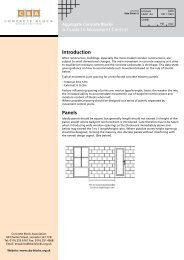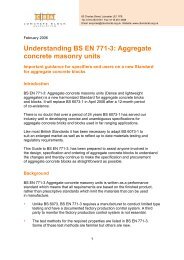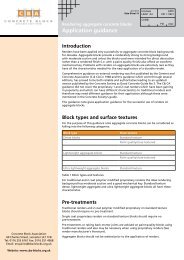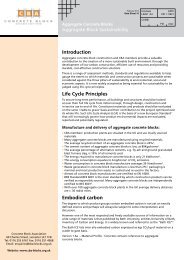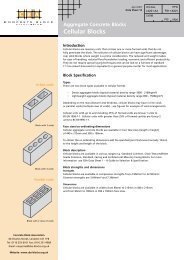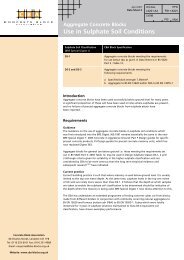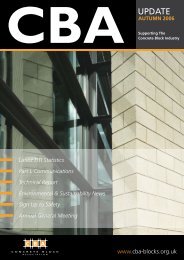Latest CBA Newsletter - Concrete Block Association
Latest CBA Newsletter - Concrete Block Association
Latest CBA Newsletter - Concrete Block Association
You also want an ePaper? Increase the reach of your titles
YUMPU automatically turns print PDFs into web optimized ePapers that Google loves.
TECHNICAL REPORT<br />
Continued from page 11<br />
Eurocode 6<br />
(BS EN 1996-1-1)<br />
Shortly after the introduction of Eurocode<br />
6 and the UK National Application<br />
Document (NAD) giving values to use<br />
in the UK for designs to Eurocode 6, it<br />
became known that designs to this code<br />
and the UK NAD were significantly more<br />
conservative than designs to BS 5628.<br />
Twelve years after a paper, anticipating<br />
Eurocode 6, with me as one of the joint<br />
authors, was published in the Structural<br />
Engineer making the case for a K factor of<br />
0.7 in the equation:<br />
f k<br />
= K f m<br />
0.3<br />
. f b<br />
0.7<br />
[the equation to calculate characteristic<br />
strength (f k<br />
) when designing to Eurocode<br />
6] the BSI mirror committee for the<br />
masonry Eurocode, has finally agreed to<br />
adjust the factor of K from 0.55 (their<br />
original choice) to 0.75 for Group 1<br />
concrete units and from 0.45 to 0.75<br />
for manufactured stone units.<br />
This agreement has taken an inordinate<br />
amount of effort analysing and<br />
re-analysing test data and putting<br />
forward numerous proposals to amend<br />
the K factors and unit shape factor<br />
corrections to try and get a straight line<br />
relationship between the fk values in BS<br />
5628-1 and those calculated according to<br />
the Eurocode 6 equation.<br />
designs are carried out to BS EN 1996-<br />
1-1 instead of advocating the use of the<br />
withdrawn BS 5628.<br />
The new UK NAD will also contain some<br />
key guidance on calculating fk values for<br />
collar-jointed walls and walls with blocks<br />
laid flat which the existing UK NAD does<br />
not provide.<br />
Flooring blocks<br />
Following a <strong>CBA</strong> initiative, it has been<br />
agreed that a national foreword can be<br />
added to BS EN 15037-2 ‘Precast concrete<br />
products. Beam and block floor systems.<br />
Part 2 <strong>Concrete</strong> blocks’ which states that<br />
blocks to BS EN 771-3 can be either<br />
7.3N/mm 2 strength with no need to test<br />
for transverse strength or alternatively<br />
they need to be tested for transverse<br />
strength according to that standard. The<br />
test method is identical to that used in the<br />
UK since blocks were first supplied for this<br />
application. This will mean that you will<br />
not have to claim compliance with BS EN<br />
15037-2 when supplying blocks for beam<br />
and block flooring and have to CE mark to<br />
2 standards.<br />
Thermal bridging<br />
details<br />
We are in the process of putting together<br />
some generic thermal bridging details for<br />
use by <strong>CBA</strong> members. There are some<br />
general details (Accredited Construction<br />
Details known as ACDs) available for<br />
downloading from a Government website<br />
but these give conservative values and we<br />
need to have dedicated thermal bridging<br />
details appropriate for constructions<br />
involving generic aggregate blocks<br />
available as these are needed for SAP<br />
calculations. This is specialist work and we<br />
are going outside for this modelling work.<br />
A typical detail for a floor/wall junction is<br />
shown left.<br />
It will be appreciated that the permutations<br />
of junction type, block type, other product<br />
type in the junction, insulation type and<br />
thickness together with the combination<br />
of positions where the insulation can be<br />
placed leads to a vast number of possible<br />
thermal bridging details. Initially we will<br />
be modelling the 17 most frequently<br />
found junctions and add to them as<br />
demand dictates.<br />
(Below) Once modelled the details will give ψ-values and f-factors for each detail modelled<br />
and models will cover λ-values for ultralightweight, lightweight and dense blocks.<br />
A revised UK NAD to BS EN 1996-1-1<br />
where the new K factors are to be found<br />
has now been accepted and is expected to<br />
be published before the summer. We will<br />
thus be able to recommend that masonry<br />
<strong>CBA</strong> Website a hit<br />
Our website continues to receive 4000<br />
- 5000 visits a month with the average<br />
visitor looking at 3 pages. The most<br />
sought after pages continue to be<br />
the 20 technical data sheets, u-value<br />
calculator and Part L 2010 Regs guide.<br />
With this in mind many of the technical<br />
data sheets have been updated over the<br />
last 12 months, for instance the one on<br />
sustainability has been comprehensively<br />
upgraded and contains more factual<br />
detail. A members only area is now up<br />
and running which contains all the Spring<br />
Update and Monthly Newsround back<br />
issues along with the Technical Commitee<br />
minutes. A facility to trade plant and<br />
equipment member to member has also<br />
been set up. Make sure that your staff<br />
and customers are aware of the ease of<br />
access to information on concrete blocks<br />
via our website. Remember that if you<br />
print the <strong>CBA</strong> QR tag ob your literature it<br />
will give smartphone users instant access<br />
to the site.<br />
www.cba-blocks.org.uk<br />
12 www.cba-blocks.org.uk




